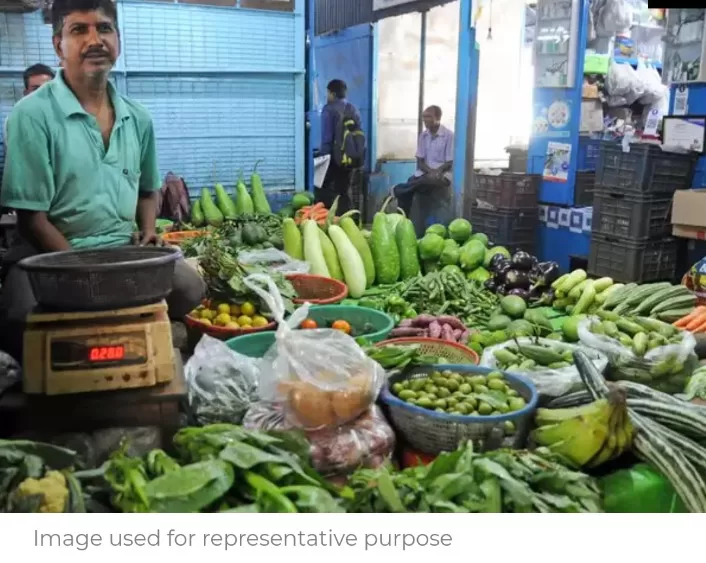New Delhi:While the Reserve Bank of India and governmental authorities may seek to downplay the recurrent fluctuations in vegetable prices by deeming them ‘transient,’ the discerning eye perceives an undercurrent of structural issues. Indeed, recent evidence suggests that such price spikes have progressively become more pronounced, necessitating short-term policy adjustments, as articulated by analysts.
The confluence of escalating incomes has notably steered Indian consumers towards an amplified penchant for non-cereal products, encompassing meat, pulses, fruits, and vegetables. This shifting demand landscape within India reveals an overt disparity between the burgeoning appetite for vegetables and the concurrent supply constraints, accentuating the structural imbalance.
Over the years, episodic escalations in vegetable prices have become a recurrent phenomenon. These phenomena can be traced to the inherent volatility within the production cycle, as well as the persistence of supply-demand incongruities. A recent CRISIL report, the arbiter of financial research, underscores the heightened volatility of vegetables, substantiating its claim by virtue of vegetables’ robust 15.5 percent weight within the food index, second only to cereals and milk.
Invariably, the return of food inflation each year signifies a recurring headache for the Indian economy. This vexation is epitomized by the cyclic ascent of prices, particularly in the context of staple vegetables such as onions and tomatoes. The causative factors are oftentimes meteorological vagaries. The year 2023 bore witness to a perturbed monsoon season, characterized by delays in June, an abundance of rainfall in July, an August deficit, and a renewed excess of precipitation in September.
Analyzing the figures, CRISIL reveals that while vegetable inflation averaged zero percent during the period spanning FY16 to FY19, it ascended to 5.7 percent in the period from FY20 to FY23. The periodicity of these price spikes has concurrently surged. The report illuminates the precariousness by showcasing that, in the past 100 months, Consumer Price Index (CPI) vegetable inflation exceeded its historical average of 3.8 percent during 49 months. A more poignant insight is that it eclipsed the 7 percent mark in 35 months, transcended 10 percent in 30 months, and even breached 20 percent in 13 months. These data points underscore an exponential rise in the volatility associated with vegetable inflation over the last three fiscal years.
It is imperative to acknowledge the erratic nature of vegetable production, characterized by year-round cultivation, heightened vulnerability to climatic perturbations and pest incursions, and a conspicuous absence of mechanisms akin to Minimum Support Price. This absence contravenes the existing paradigm established for cereals and pulses, which are distinctly seasonal, enjoy certain price signaling mechanisms, and possess assured governmental procurement.
Concurrently, a substantial contributor to the intensification of vegetable prices is the perpetual supply-demand incongruity. Notably, India reigns as the world’s second-largest producer of vegetables, yielding only to China. Nevertheless, India’s per capita vegetable production has risen less than twice over a span of two decades, accentuating the disquieting rift between supply and demand dynamics.
Albeit the nation has realized substantial growth in terms of vegetable acreage and aggregate production, the forward momentum has progressively waned, and yield levels have stagnated. Furthermore, CRISIL contends that the cumulative losses incurred throughout the harvesting, packaging, transportation, storage, and marketing phases are both substantial and protracted.
The prominence of vegetables such as potatoes could ostensibly have encountered more favorable outcomes, provided the nation invested in expanding cold storage infrastructure. This underscores the indispensable role of technological interventions and infrastructure enhancements in mitigating losses, which in turn, serve to bolster the overall supply of vegetables. The ultimate objective is to alleviate the deficits that contribute to inflationary spikes.
The abrupt surges in vegetable prices extend their implications beyond policy realms, transcending into the realm of consumerism. Such price upheavals impair consumers’ purchasing capacity, especially in relation to discretionary expenditures. At the same time, farmers are compelled to make uncertain production decisions, given the absence of robust price signaling mechanisms. This, in turn, can culminate in the cobweb pattern, wherein pricing dynamics in one cropping season significantly influence sowing decisions in the subsequent season, thereby perpetuating the cyclical nature of the conundrum.
Analysts posit that the enhancement of productivity within the Indian vegetable production sector should be a priority to stimulate profitability and mitigate risks for cultivators. On the infrastructural front, streamlining efficiency across the supply chain offers the potential to curtail losses incurred within the purview of cold storage, transportation, and marketing.






